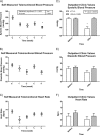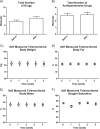Difficult-to-control hypertension: identification of clinical predictors and use of ICT-based integrated care to facilitate blood pressure control
- PMID: 29713051
- PMCID: PMC6057905
- DOI: 10.1038/s41371-018-0063-0
Difficult-to-control hypertension: identification of clinical predictors and use of ICT-based integrated care to facilitate blood pressure control
Abstract
Difficult-to-control (DTC) hypertension represents a burden in real life that can be partially solved through identification of the characteristics of clinical patterns and tailoring antihypertensive strategies, including ICT-enabled integrated care (ICT-IC). In the quest for clinical predictors of DTC hypertension, we screened 482 hypertensive patients who were consecutively referred to the departmental hypertension clinic. Following a data quality check, patients were divided into controlled (C, 49.37%) and uncontrolled (UC, 50.63%) groups based on their systolic blood pressure (BP) at follow-up. We then performed statistical analysis on the demographic, clinical, laboratory, and ultrasound data and observed that older age, female sex, higher BP levels, and a family history of hypertension were predictors of DTC hypertension. We then developed a pilot service of ICT-IC, including weekly home visits by nurses and patient education on self-monitoring of BP, heart rate, body weight, and oxygen saturation using 3G-connected devices. Self-monitored data were transmitted to the hospital servers on the electronic chart of the patient for remote assessment by the hospital hypertension specialists. A total of 20 UC patients (M/F = 10/10; age: 72.04 ± 2.17 years) were enrolled to verify the efficacy of BP control without changes in medical treatment. After 1 month of the ICT-IC program, BP was reduced both at the office assessment (systolic BP (SBP): 162.40 ± 2.23 mm Hg, beginning of the program vs. 138.20 ± 4.26 mm Hg at 1 month, p < 0.01) and at home (SBP: 149.83 ± 3.44, beginning of the program vs. 134.16 ± 1.67 mm Hg at 1 month, p < 0.01). We concluded that DTC hypertension can be predicted based on the clinical characteristics at the first visit. For these patients, ICT-IC is a feasible therapeutic strategy to achieve BP control.
Conflict of interest statement
The authors declare that they have no conflict of interest.
Figures



Similar articles
-
An ICT and mobile health integrated approach to optimize patients' education on hypertension and its management by physicians: The Patients Optimal Strategy of Treatment(POST) pilot study.Annu Int Conf IEEE Eng Med Biol Soc. 2016 Aug;2016:517-520. doi: 10.1109/EMBC.2016.7590753. Annu Int Conf IEEE Eng Med Biol Soc. 2016. PMID: 28324932
-
Personalized Hypertension Management Using Patient-Generated Health Data Integrated With Electronic Health Records (EMPOWER-H): Six-Month Pre-Post Study.J Med Internet Res. 2017 Sep 19;19(9):e311. doi: 10.2196/jmir.7831. J Med Internet Res. 2017. PMID: 28928111 Free PMC article.
-
Antihypertensive treatment based on blood pressure measurement at home or in the physician's office: a randomized controlled trial.JAMA. 2004 Feb 25;291(8):955-64. doi: 10.1001/jama.291.8.955. JAMA. 2004. PMID: 14982911 Clinical Trial.
-
Ambulatory versus clinic blood pressure for the assessment of anti hypertensive efficacy in clinical trials: insights from the Val-Syst Study.Clin Ther. 2004 Sep;26(9):1436-45. doi: 10.1016/j.clinthera.2004.09.003. Clin Ther. 2004. PMID: 15531006 Clinical Trial.
-
Management of hypertension in the digital era: Perspectives and future directions.Hipertens Riesgo Vasc. 2022 Apr-Jun;39(2):79-91. doi: 10.1016/j.hipert.2022.01.004. Epub 2022 Feb 21. Hipertens Riesgo Vasc. 2022. PMID: 35210178 Review.
Cited by
-
Uncontrolled blood pressure and contributing factors among patients with hypertension at outpatient care of Bedele General Hospital, Southwest Ethiopia: A cross-sectional study.SAGE Open Med. 2022 Sep 26;10:20503121221126333. doi: 10.1177/20503121221126333. eCollection 2022. SAGE Open Med. 2022. PMID: 36187360 Free PMC article.
-
Editorial: Multi-Actor Collaboration in Healthcare to Address the Emerging Health Needs of an Aging Population.Transl Med UniSa. 2019 Jan 6;19:1-4. eCollection 2019 Jan-Jun. Transl Med UniSa. 2019. PMID: 31360660 Free PMC article. No abstract available.
-
Uncontrolled blood pressure and associated factors in adult hypertensive patients undergoing follow-up at public health facility ambulatory clinics in Bishoftu town, Ethiopia: a multi-center study.BMC Cardiovasc Disord. 2023 May 17;23(1):258. doi: 10.1186/s12872-023-03290-z. BMC Cardiovasc Disord. 2023. PMID: 37198582 Free PMC article.
-
Barriers, Enablers and Strategies for the Treatment and Control of Hypertension in Nepal: A Systematic Review.Front Cardiovasc Med. 2021 Oct 11;8:716080. doi: 10.3389/fcvm.2021.716080. eCollection 2021. Front Cardiovasc Med. 2021. PMID: 34708082 Free PMC article.
-
"One Health" Approach for Health Innovation and Active Aging in Campania (Italy).Front Public Health. 2021 May 11;9:658959. doi: 10.3389/fpubh.2021.658959. eCollection 2021. Front Public Health. 2021. PMID: 34046390 Free PMC article. Review.
References
-
- Dasgupta K, Quinn RR, Zarnke KB, Rabi DM, Ravani P, Daskalopoulou SS, et al. The 2014 Canadian Hypertension Education Program recommendations for blood pressure measurement, diagnosis, assessment of risk, prevention, and treatment of hypertension. Can J Cardiol. 2014;30:485–501. doi: 10.1016/j.cjca.2014.02.002. - DOI - PubMed
Publication types
MeSH terms
Substances
LinkOut - more resources
Full Text Sources
Other Literature Sources
Medical

